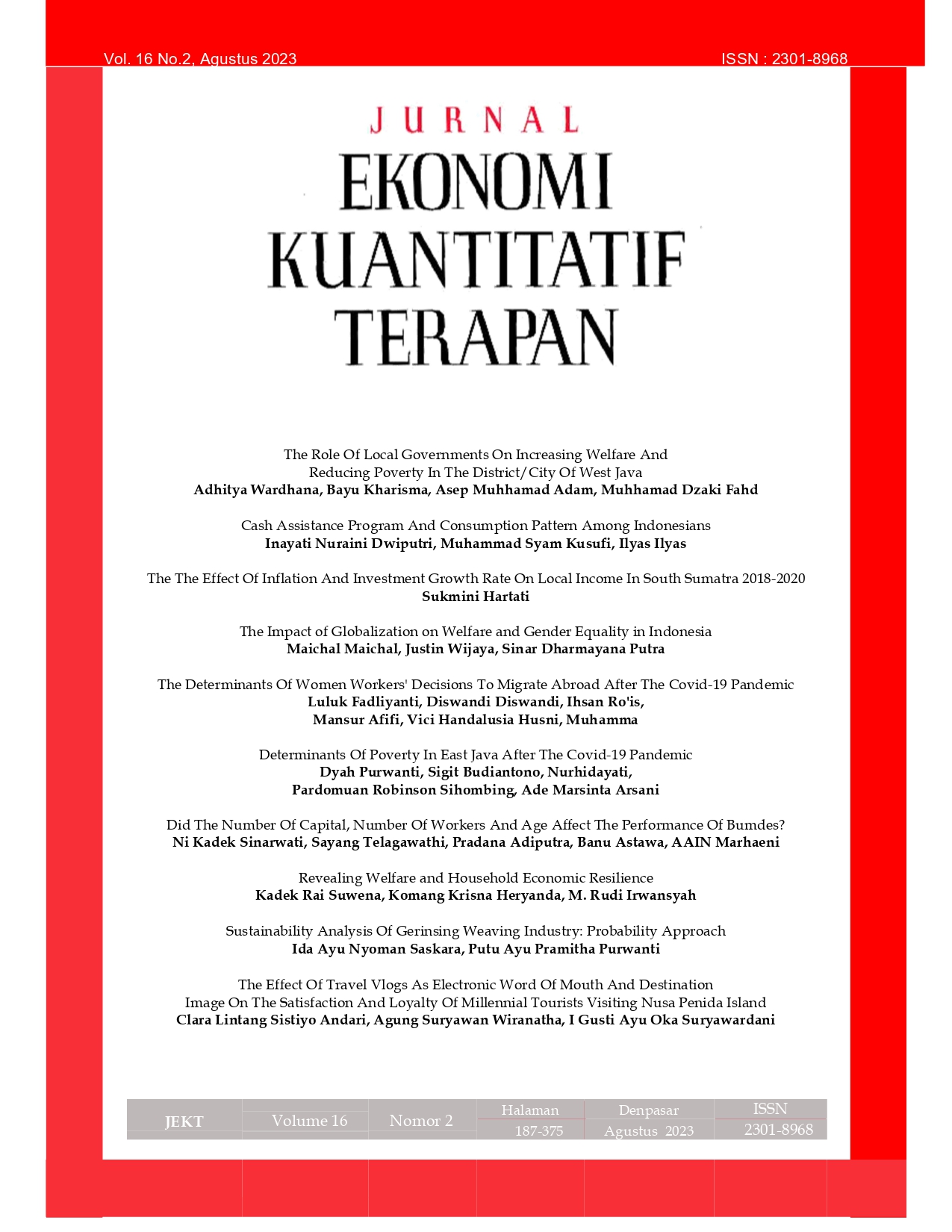Sustainability Analysis Of Gerinsing Weaving Industry: Probability Approach
SUSTAINABILITY ANALYSIS OF GERINSING WEAVING INDUSTRY: PROBABILITY APPROACH
Abstract
The gerinsing weaving (tenun gerinsing) craft industry is a culture-based creative industry that has its own values ??and characteristics as a local cultural heritage. It can also link traditional knowledge with innovation and creativity which is considered important for a number of developing countries because it has economic potential and has an impact on economic development. Karangasem as one of the regencies in Bali which is full of culture-based woven crafts industries such as geringsing woven fabrics.There are many stakeholders who care about and have an interest in the sustainability of the gringsing weaving industry. The existence of uncertainty also cannot be ruled out to maintain its sustainability. The objectives to be achieved in this study are: 1) to determine the probability scenario of grinsing weaving sustainability; 2) to determine the sensitivity of scenarios driving the sustainability of grinsing weaving in Tenganan Pegringsingan Village, Karangasem.
Primary data were obtained from respondents through distributing questionnaires to craftsmen, consumers and stakeholders. The distribution of this questionnaire is a survey to obtain data as a comparison of the results of Focus Group Discussion (FGD) with experts who will later determine the probability scenario of sustainability. The prospective analysis used in this study is the SMIC-Prob analysis.
ResultsThe analysis shows that of the four (4) scenarios formulated as a result of the FGD with experts, there is a combination of scenarios with the highest conditional opportunity, namely the 1101 combination, which means that the scenario of craftsmen producing as usual, apart from producing, also side comersial, and reducing production is the best combination with probability 0.124. While the sensitivity of the scenario is shown with the highest elasticity results in the increase scenario (increasing production) of 1.422, which is heavily influenced by the scenario of continuing to produce as usual of -0.624, which means that every 100% increase in the chance of producing as usual will reduce the chance of craftsmen increasing production by as much as 62.4 percent.
Downloads
References
Balaji, N. C., & Mani, M. (2014). Sustainability in traditional handlooms. Environmental Engineering and Management Journal, 13(2), 323–331. https://doi.org/10.30638/eemj.2014.037
Boateng, B. (2011). (2011). The copyright thing doesn’t work here: Adinkra and Kente cloth and intellectual property in Ghana. University of Minnesota Press.
Cecep Rukendi. (n.d.). No Title Menparekraf Sandiaga Uno Siapkan Kain Tenun Gringsing Jadi Souvenir di KTT G20. https://pedulicovid19.kemenparekraf.go.id/siaran-pers-menparekraf-sandiaga-uno-siapkan-kain-tenun-gringsing-jadi-souvenir-di-ktt-g20/
Cooke, P., & de Propris, L. (2011). A policy agenda for EU smart growth: The role of creative and cultural industries. Policy Studies, 32(4), 365–375. https://doi.org/10.1080/01442872.2011.571852
Fahmi, F. Z., & Dijk, J. van. (2016). Creative industries and regional economic development in Indonesia : meanings, patterns and impacts. 161.
Fauzi, A. (2019). Teknik Analisis Keberlanjutan. In PT Gramedia Pustaka.
Galloway, S., & Dunlop, S. (2007). a Critique of Definitions of the Cultural and Creative Industries in Public Policy. International Journal of Cultural Policy, 13(1), 17–31. https://doi.org/10.1080/10286630701201657
Garnham, N. (2005). From cultural to creative industries: An analysis of the implications of the “creative industries” approach to arts and media policy making in the United Kingdom. International Journal of Cultural Policy, 11(1), 15–29. https://doi.org/10.1080/10286630500067606
Godet, M., Monti, R., Meunier, F., & Roubelat, F. (2004). SCENARIOS AND STRATEGIES - A Toolbox for Problem Solving. 101.
Huggins, R., & Thompson, P. (2015). Culture and Place-Based Development: A Socio-Economic Analysis. Regional Studies, 49(1), 130–159. https://doi.org/10.1080/00343404.2014.889817
Lodra, I. (2016). Komodifikasi Makna Tenun Gringsing sebagai “Soft Power” Menghadapi Budaya Global. Jurnal Kajian Bali, 6(1), 211–222–211–222.
Maha Putra, G. (2017). Defining and Sustaining The Place-Identity of A Traditional Yet Rapidly Developing City. Oxford Brookies University.
O’Connor, J. (2007). The cultural and creative industries: a review of the literature. In Creative Partnerships London. http://kulturekonomi.se/uploads/cp_litrev4.pdf
Parameswara, A., Saskara, I. A. N., Utama, I. M. S., & Setyari, N. P. W. (2022). Exploring Cultural Value and its Sustainability of Balinese Handwoven Textiles. Textile: The Journal of Cloth and Culture, 0(0), 1–24. https://doi.org/10.1080/14759756.2022.2043517
Pessoa, J., Deloumeaux, L., & Ellis, S. (2009). The 2009 Unesco framework for cultural statistics (FCS). Unesco Institute for Statistics.
Pratt, A. C., & Jeffcutt, P. (2009). Creativity, innovation and the cultural economy. In Creativity, Innovation and the Cultural Economy. https://doi.org/10.4324/9780203880012
Pratt, D. A. C. (2007). The state of the cultural economy: the rise of the cultural economy and the challenges to cultural policy making. 1st ed(Book, Whole), 270 p.
Ryan Puspa Bangsa. (2021). Sandiaga Uno Pekerjakan Semua Pengrajin Tenun Desa Tengganan. https://www.gatra.com/detail/news/523903/ekonomi/sandiaga-uno-pekerjakan-semua-pengrajin-tenun-desa-tengganan
Throsby, D. (2001). Economics and culture. In published by the press syndicate of the university of cambridge The Pitt Building, Trumpington Street, Cambridge, United Kingdom. published by the press syndicate of the university of cambridge The Pitt Building, Trumpington Street, Cambridge, United Kingdom. https://doi.org/10.21098/bemp.v22i1.1035
Widiawati, D., Sn, S., Sn, M., Rosandini, M., & Ds, S. (2012). Natural Dyes on Indonesian Traditional Textiles - A Case Study: Geringsing Woven Fabric, In Tenganan Pegeringsingan Village Bali -. The Research Journal of the Costume Culture, 20(1), 111–120. https://doi.org/10.7741/rjcc.2012.20.1.111
Yang, J., & Černevičiūtė, J. (2017). The International Journal ENTREPRENEURSHIP AND SUSTAINABILITY ISSUES CULTURAL AND CREATIVE INDUSTRIES (CCI) AND SUSTAINABLE DEVELOPMENT: CHINA’S CULTURAL INDUSTRIES CLUSTERS *. 5(6), 231–242. http://jssidoi.org/jesi/http://doi.org/10.9770/jesihttp://doi.org/10.9770/jesi.2017.5.2
Yang, Y., Shafi, M., Song, X., & Yang, R. (2018). Preservation of cultural heritage embodied in traditional crafts in the developing countries. A case study of Pakistani handicraft industry. Sustainability (Switzerland), 10(5). https://doi.org/10.3390/su10051336




















